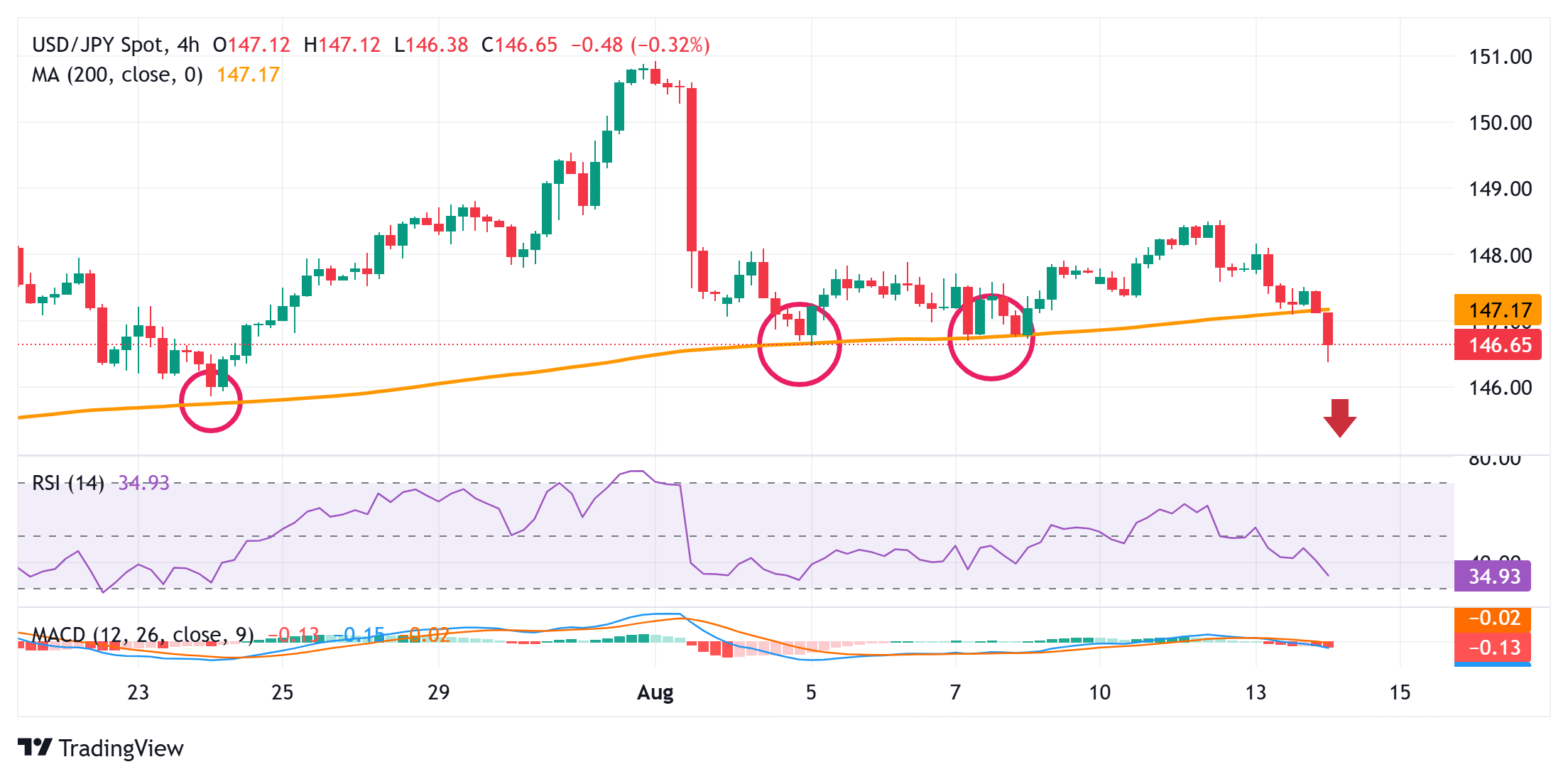
The Japanese Yen strengthens against the USD for the third consecutive day on Thursday.
The divergent BoJ-Fed expectations continue to drive flows towards the lower-yielding JPY.
Even the risk-on mood does little to dent the bullish sentiment around the safe-haven JPY.
The Japanese Yen (JPY) prolongs its uptrend against a broadly weaker US Dollar (USD) for the third straight day and spikes to over a three-week high during the Asian session on Thursday. The growing acceptance that the Bank of Japan (BoJ) will stick to the policy normalization path and hike interest rates by the end of this year continues to underpin the JPY. Meanwhile, hawkish BoJ expectations mark a big divergence in comparison to rising bets that the Federal Reserve (Fed) will restart its rate-cutting cycle in September. This, in turn, keeps the USD depressed near its lowest level in over two weeks and contributes to driving flows towards the lower-yielding JPY.
The aforementioned supporting factors, to a large extent, offset the prevalent risk-on environment and do little to dent a strong bullish sentiment surrounding the safe-haven JPY. Meanwhile, concern about consumption-led recovery amid a fall in Japan's real wages for the sixth straight month in June and the potential negative impact of higher US tariffs on the economy suggest that the prospects for further BoJ rate hikes could be delayed. This might hold back the JPY bulls from positioning for a runaway rally. Traders now look to the release of the US Producer Price Index (PPI) for some impetus later today, ahead of Japan's Preliminary Q2 GDP print on Friday.
JPY bulls regain control as BoJ’s relatively hawkish outlook offsets positive risk tone
The Bank of Japan's hawkish stance in July, signaling that it will raise interest rates further if growth and inflation continue to advance in line with estimates, pushes the Japanese Yen higher for the third straight day on Thursday.
The US Dollar, on the other hand, hangs near its lowest level in more than two weeks amid the growing acceptance of an imminent interest rate cut by the Federal Reserve at the upcoming monetary policy meeting in September.
The expectations were reaffirmed by a series of disappointing US macroeconomic data released recently, including the closely watched Nonfarm Payrolls report for July, which pointed to signs of deteriorating labor market conditions.
Adding to this, the broadly in-line US consumer inflation figures on Tuesday backed the view that recent tariff-related price pressures will be largely transitory and lifted bets for more rate cuts by the Fed than previously expected.
Data released last week showed that Japan's real wages fell for the sixth consecutive month in June. Adding to this, a deceleration in Japan's Corporate Goods Price Index (CGPI) fueled concern about a consumption-led recovery.
Furthermore, domestic political uncertainty and concerns about the economic impact of higher US tariffs suggest that the prospects for BoJ policy normalization could be delayed. This, however, does little to impress the JPY bears.
The global risk sentiment remains supported by expectations for more rate cuts from the US Fed, an extension of the US-China tariff truce for three months, and the optimism over the US-Russia summit aimed at ending the Ukraine war.
The risk-on mood lifted Japan’s Nikkei225 to the 43,000 level for the first time ever on Wednesday. Moreover, the benchmark S&P 500 and the tech-heavy Nasdaq Composite Index scored record highs for the second straight session.
Traders now look forward to the release of the US Producer Price Index, which, along with comments from influential FOMC members, will drive the USD demand and provide some impetus to the USD/JPY pair later this Thursday.
The market attention will then shift to the Preliminary Q2 GDP print from Japan and the University of Michigan US Consumer Sentiment Index on Friday. Nevertheless, the fundamental backdrop seems tilted in favor of the JPY bulls.
USD/JPY turns vulnerable below 200-SMA pivotal support on H4

From a technical perspective, an intraday breakdown and acceptance below the 200-period Simple Moving Average (SMA) on the 4-hour, around the 147.00 mark, could be seen as a fresh trigger for the USD/JPY bears. However, the Relative Strength Index on the said charts has moved to the verge of breaking into the oversold zone, making it prudent to wait for some intraday consolidation or a modest bounce before positioning for deeper losses. That said, any attempted recovery is more likely to attract fresh sellers and remain capped near the 147.00 support-turned-resistance. The latter should now act as a key pivotal point, which, if cleared decisively, could trigger a short-covering move towards the 147.45-147.50 region.
On the flip side, the USD/JPY pair seems poised to slide towards testing sub-146.00 levels (July 24 low) before extending the fall further to the next relevant support near the 145.40-145.30 region. The downward trajectory could eventually drag spot prices to the 145.00 psychological mark.
* The content presented above, whether from a third party or not, is considered as general advice only. This article should not be construed as containing investment advice, investment recommendations, an offer of or solicitation for any transactions in financial instruments.


